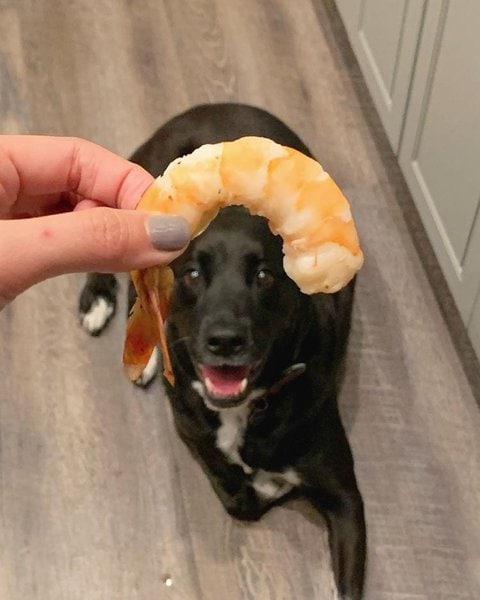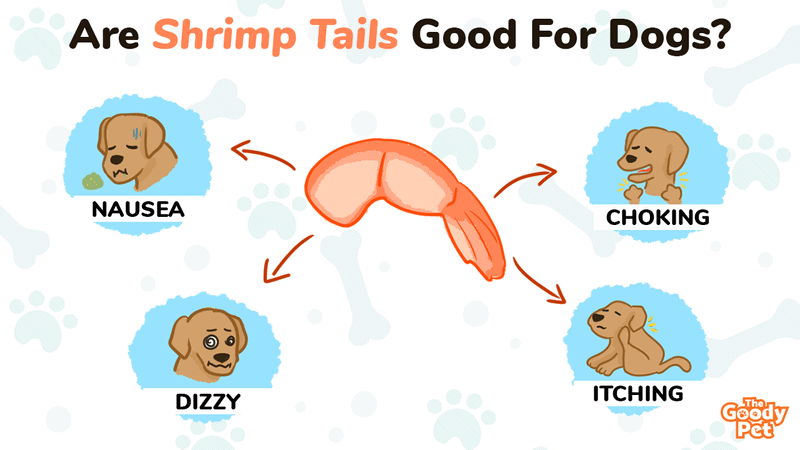It is really tempting to toss the shrimp tails to your furry friend. But as a responsible dog parent, you would like to check whether you should give your dog shrimp tails or not.
Do not let your pup chew or eat shrimp tails, as it causes choking or blocks the digestive tract. The sharp corners of a shrimp tail can also irritate the upper gastrointestinal tract of your pup. In addition, raw shrimp tails can make your dog sick due to the bacterial content they harbor.
You can give a limited amount of cooked shrimp to your pup but never give shrimp tails, whether cooked or raw.
Now, let’s look into details about what makes shrimp tails a bad food for your pup. But first, let’s see whether shrimp tails are fit for consumption or not.
Are Shrimp Tails Digestible By Dogs?
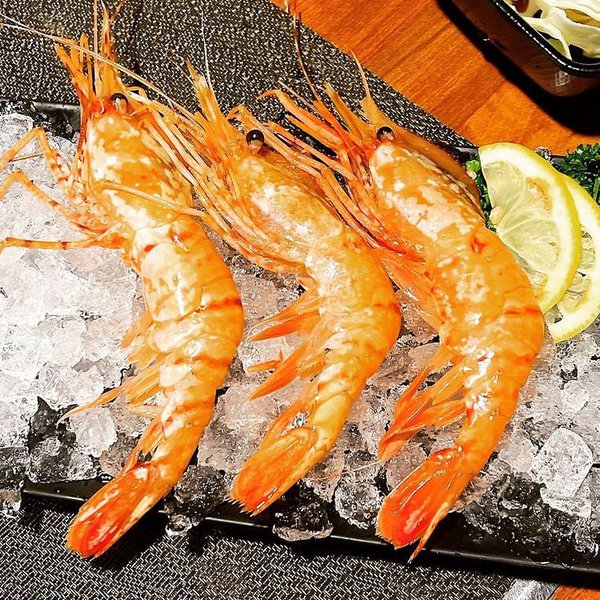
No, dogs cannot digest shrimp tails as these are made of chitin, which is tough for dogs’ digestive systems to break down.
Many people choose not to eat shrimp tails as it is a matter of personal preference for them. But for your dog, it is a matter of safety as shrimp tails are relatively difficult to chew and digest.
Although smaller tails are comparatively chewable, swallowing them is tricky and hurts your dog. If the shrimp is large, the tails will be more rigid, and even boiling or cooking won’t soften them enough to be consumable by your pup.
What Is The Material Of Shrimp Tails?
Shrimp tails are pretty rigid and chewy, so they can stick into your pup’s throat and can cause severe issues.
Moreover, if you love to bring large shrimps at home, such as colossal or jumbo, remember that these shrimps have more giant tails. So, take them away from your puppy at any cost, as they can be a choking hazard.
Even the more petite shrimp tails are made of chitin, which is quite tough to digest for dogs. Their digestive system lacks the enzyme that is necessary to break down chitin. Hence, it is best to keep your dog away from shrimp tails.
What Happens If My Dog Eats Shrimp Tails?
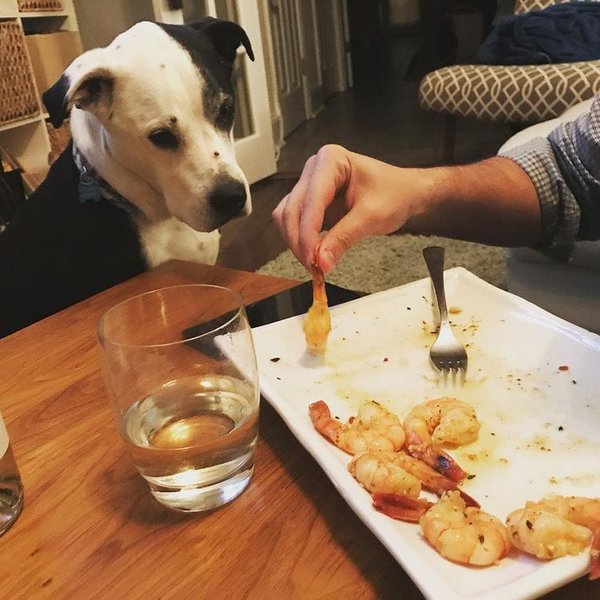
If your dog has accidentally or deliberately eaten the shrimp tail, it will suffer from nausea, diarrhea, vomiting, cramps, and abdominal pain. Shrimp tails are tough to digest, even for humans, due to their brittle composition material.
Nausea
Feeding shrimp tails to your dogs can cause nausea, making pups uncomfortable and queasy. When a dog eats a shrimp tail, it is an unpleasant change in its body, mainly in the gastrointestinal tract.
If not treated on time, nausea can turn into cancer, chronic kidney failure, acute kidney failure, parvovirus, and diabetes mellitus.
Vomiting
As mentioned earlier, shrimp tails are tough to chew and swallow. So, when your puppy forcefully ingests them, it disturbs the upper intestine of your pup.
You won’t believe it, but shrimp shells are toxic for dogs as they can lead to severe vomiting, which can turn into serious illness. In such situations of chronic vomiting, make sure to run to your vet.
Diarrhea
Consuming shrimp tails is included in dietary indiscretion as it can lead your dog to diarrhea. When your pup eats shrimp shells or tails, it causes digestion issues and brings up loose stools in large amounts.
Diarrhea is not a disease itself but can chain up many different life-threatening diseases. Therefore, it is better to run to your vet if your dog starts to have loose stool or suffers from weakness.
Are Shrimp Tails Good For Dogs?
Shrimp tails are not good for dogs. Its consumption can pose a number of health and safety concerns to dogs, such as choking, allergies, or bacterial infections.
Choking
Firstly, shrimp tails are tiny and can easily choke your dog. Be more careful with smaller dog breeds as they are at higher risks.
In contrast to chicken or turkey bones, shrimp tails remain hard after cooking. So, even properly cooking them won’t make any difference.
Viruses And Bacterial Infections
Offering raw shrimp tails is a bad idea due to bacteria, viruses, or even parasites on them.
Food Allergies
Here is another reason not to feed shrimps to your dog. Food allergies are pretty common in dogs, and you often have no idea how your dog will react to the newly introduced food.
Although being allergic to seafood is less common than chicken, soy, or milk allergies, it can still happen, resulting in symptoms.
- Dizziness
- Vomiting
- Itching
- Stomach upset
- Diarrhea
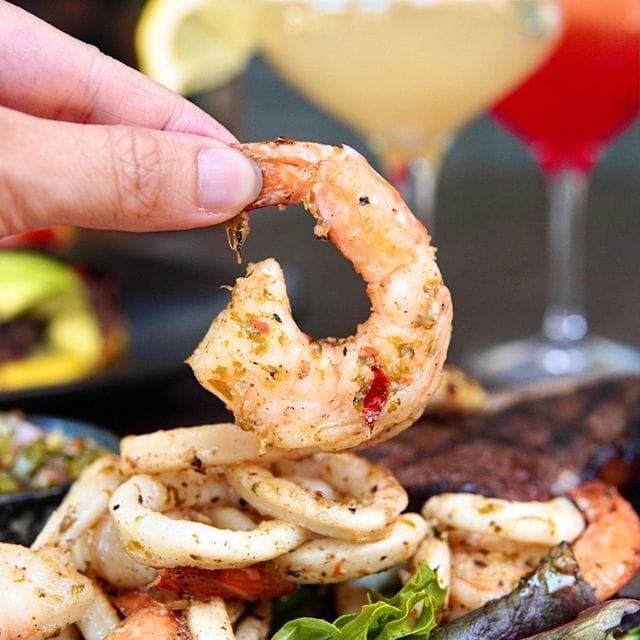
So to be on the safe side, make sure to serve them half shrimp first and note his reaction. If your pup throws up or starts coughing, immediately take it to the vet as it can be a severe issue.
Other than that, if your puppy is overweight and on a diet, then make sure not to feed it shrimps without asking your vet. Otherwise, these minor issues can lead your dog to severe health problems.
Internal Injuries
It is no surprise because shrimp tails with sharp edges can cause internal injuries, particularly in the gestational tract. Additionally, they can obstruct the airways, causing difficulty in breathing.
Higher Cholesterol Levels
Shrimps have 85% more cholesterol than other seafood, such as tuna or sardines. Regardless of the parts served, they are replete with high cholesterol.
If your dog is overweight or suffering from hyperlipidemia, avoid foods high in cholesterol as shrimps.
Which Parts Of Shrimp Should Be Fed To Your Dog?
Your pup can eat the soft shrimp meat that you get after removing the head, shell, and especially the tail.
The outer parts of shrimps act as a rigid shield for them, and that’s why they are difficult to chew and digest. After you’ve peeled and deveined the shrimp, cut them into small pieces so that your pet can chew on them easily.
Other than that, you also have to be careful which shrimp you are buying for your puppy. Make sure to get your hands only on the high-quality ones because pups are pretty sensitive when it comes to their food. Once you buy the best shrimps from the market, here is how to cook them for your little furry friend.
Proper Way Of Cooking Shrimps For Your Pup
First of all, wash the shrimp properly and make sure it is free of all the harmful chemicals. Afterward, boil it because seafood, including shrimps, contains microorganisms and bacteria that can harm your pup.
Never serve raw shrimps to your dogs as some shellfishes are contaminated and can cause neurological issues, paralysis, and gastrointestinal problems.
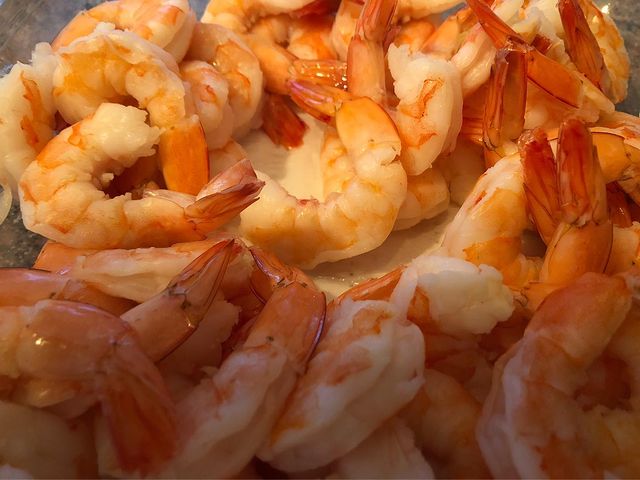
Remove Tails & Shells
Here comes the most crucial part that is removing shrimp tails and shells. As shrimp tails are pretty brittle, removing them when shrimps are raw is challenging. Make sure to remove the shrimp’s intestinal tract as it can upset your puppy’s stomach.
Don’t Add Seasoning
When we cook shrimp, we add seasoning and spices to it but don’t! Seasoning is a big no when making shrimps for your pups as it can upset your puppy’s stomach and cause abdominal pain. Make sure you don’t pour any cocktail sauce, onion, garlic, or cajun seasoning when serving shrimps to your pup.
Should Your Dog Eat Shrimps At All?
Yes, you can give a moderate amount of shrimp to your dog because they are low in fat and calories. But, you should only feed your pup the meat inside the shrimps, not the shells or the tails.
When fed in moderation, shrimps can be a great source of nutrition, but serving too much to your dogs can lead to health issues. Here are some nutrients that shrimps offer to your pup.
Phosphorus
Shrimps contain many healthy nutrients, including phosphorus for dogs, and it helps your puppy keep its bones and teeth healthy. Besides that, shrimps comprise antioxidants that play a vital role in fighting free radicals and sharpening your pup’s brain.
Vitamin B12
Shrimps are good in taste and have vitamin B12, which is excellent for maintaining dogs’ metabolic processes and preventing gastrointestinal issues.
Niacin
Niacin, also called vitamin B3, comes with shrimps and keeps the enzyme system of your pup healthy and strong. Moreover, niacin helps your puppy in proper fat production, chemical signals, blood circulation, and energy production.
